SafeHome.org may receive compensation from some providers listed on this page. Learn More
We may receive compensation from some providers listed on this page. Learn More
SafeHome.org may receive compensation from some providers listed on this page. Learn More
We may receive compensation from some providers listed on this page. Learn More
We tested over $1,200 worth of Frontpoint equipment and found a dependable DIY home security system with extensive smart home compatibility.
Price-wise, Frontpoint offers a nice middle ground between full-service home security companies like Vivint and ADT, and DIY companies like SimpliSafe and Cove. It requires a monitoring subscription with a three-year contract, but Frontpoint’s installation is entirely DIY. That’s how they keep prices affordable.
That approach has worked for Frontpoint over the years. It has been able to maintain a spot in our list of the best security systems because of the overall value it provides. That said, we believe that picking the right security system for your home starts with understanding what you specifically need, and then finding a security system that can address those needs. We purchased, installed, and thoroughly tested a Frontpoint security just so we can show you what it’s capable of. Here’s our full hands-on experience.
Check out more recommendations from the SafeHome team:
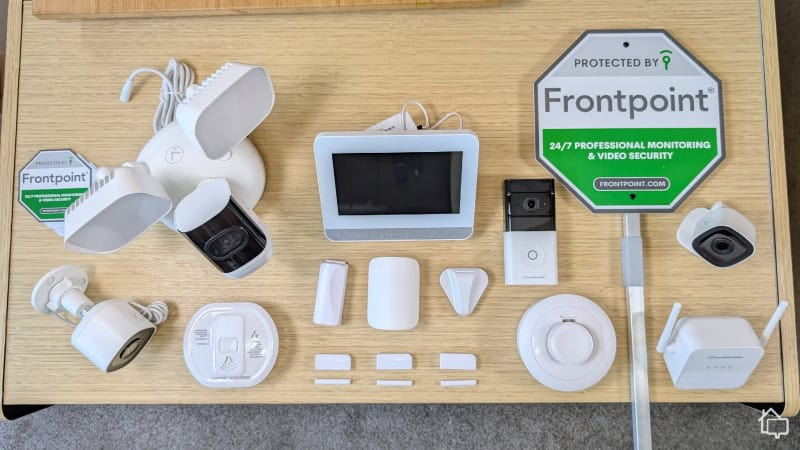
Our $1,200+ Frontpoint equipment laid out on a desk.
We found Frontpoint’s buying process pretty intuitive and straightforward. We bought a package through their website (you can also call for a quote), and while building out our system, we could see exactly how much it was going to cost us. We ended up spending over $1,200 on equipment for a comprehensive Frontpoint home security system.
At checkout, Frontpoint presented us with the “most popular” option for professional monitoring, which also happens to be their most expensive plan. Unfortunately – and this is one thing we don’t like about Frontpoint – if you want a more affordable monitoring plan, you’re going to have to call sales. We didn’t; with our package, we felt that the $49.99 per month fee for the priciest monitoring plan was worth it.
>> Learn More: The Best No-Contract Home Security Systems of 2026

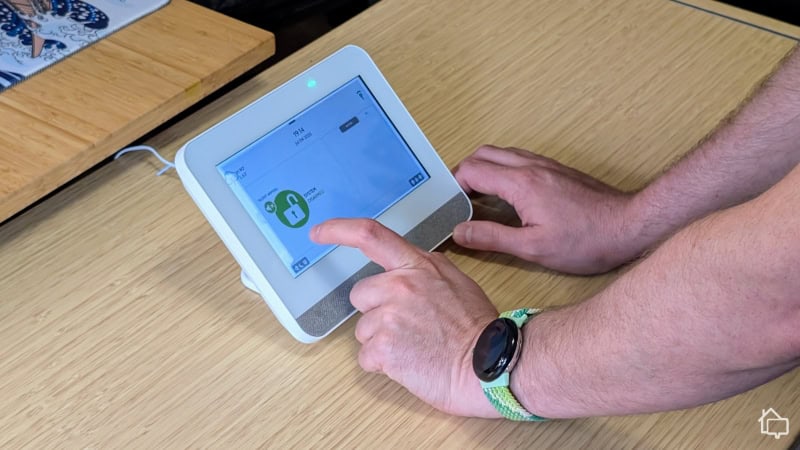
Testing the Frontpoint touch-screen controller after activating our monitoring service.
We’re a fan of flexibility when it comes to monitoring contracts, and Frontpoint offers options. The month-to-month plan lets you cancel at any time, while the contract option locks in your rate for the agreement duration. There are also a few exceptions that allow you to cancel your contract.1
If you’re considering a contract, here’s how Frontpoint compares to other major security companies’ optional long-term agreements:
| Contract details | Frontpoint | ADT | Vivint |
|---|---|---|---|
| Initial term | 36 months | 36 months | Up to 60 months |
| Money-back guarantee | 30 days | 180 days | 3 days |
| Early termination fee | 80% of remaining contract value | 75% of remaining contract value | 100% of remaining contract value (except for extenuating circumstances) |
| Monthly charges | $49.99 per month | $34.99 to $49.99 | $29.99 to $49.99 |
| Monthly fee increase | Frontpoint has the right to increase the fee by no more than 9 percent per year | ADT has the right to increase the fee after the first year | Vivint has the right to increase or change the monthly fee at any time |
| Late charge | 1.5% plus a 5% administrative fee | Up to $25 per month plus administrative fees | Depends on location (e.g. $10 in California) |
| Total contract value | $1,799.64 (monthly fee multiplied by initial term length) | At least $1,259.64 (based on $34.99 monthly fee) | At least $1,079.64 (based on $29.99 monthly fee) |
| Automatic renewal | Month to month after the initial term | Month to month after the initial term | Month to month after the initial term |
| Limited warranty | 3 years starting at activation | 1 year starting at the date of purchase | 120 days starting at activation |
Frontpoint’s 30-day money-back guarantee matches the industry standard. It lets you return the equipment and cancel your contract without penalties. It’s shorter than ADT’s 6-month money-back window or SimpliSafe’s 60-day return period, but it’s still longer than Vivint’s 3-day buyer’s remorse grace period. Just note that if you cancel your contract past the 30-day window, you’d be responsible for 80 percent of your contract balance.
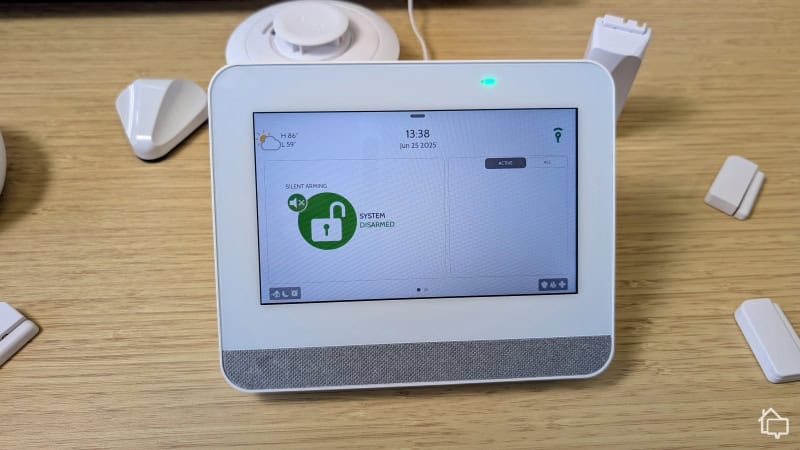
Our Frontpoint touch-screen keypad next to some of the sensors it monitors and controls.
Frontpoint’s Ultimate Monitoring Plan, which is the only option available online, is $49.99 per month. It includes every monitoring feature Frontpoint provides:
Pro Tip: We suggest keeping an eye on Frontpoint’s website for a sale. We’ve seen them offer everything from free equipment upgrades to several months of free monitoring, which can save you hundreds of dollars upfront.
Frontpoint’s base price is competitive with Vivint and not much more than ADT, especially when you realize that Frontpoint comes with smart home and security camera controls, which add up quickly with Vivint.
While SimpliSafe, Cove and Ring Alarm keep their monthly fees lower, Frontpoint’s pricing becomes more reasonable when you look closer at what’s included. For instance, Ring’s comparable feature set runs $20 per month with professional monitoring. That’s about $30 less than Frontpoint, though it lacks some of the advanced integrations.
Frontpoint also offers a separate In-App Personal Safety Button plan that costs $4.99 per month. You can press and hold this virtual button from anywhere, including outside of your home. Releasing it triggers an emergency response to your GPS location.
While Frontpoint’s Ultimate Professional Monitoring plan covers most features, you can enhance your system with these optional add-ons:
Expert Advice: Frontpoint made our list of the most affordable home security systems thanks to its frequent deals. Don’t forget to check out Frontpoint’s current promotions. The company occasionally offers discounted monitoring and equipment packages.
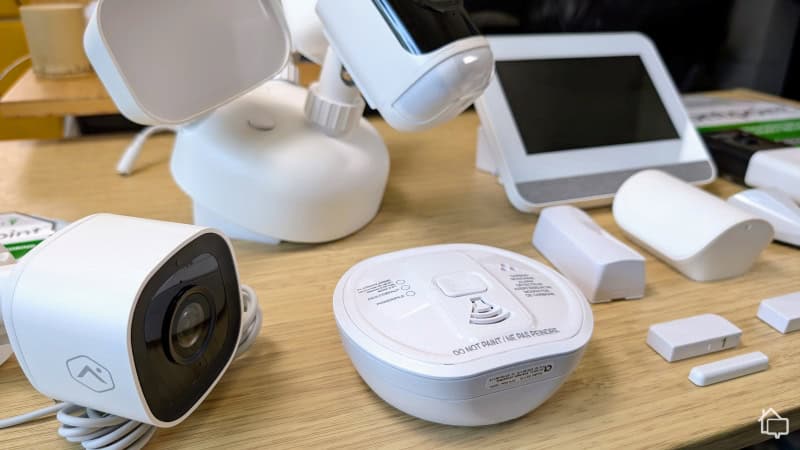
We bought a variety of Frontpoint equipment, including security cameras, security sensors and safety sensors.
For our testing, we purchased a custom package containing 18 pieces of equipment and accessories. The retail price was almost $2,000, but promotional discounts brought our final cost down to around $1,200. Here’s what we got:
FYI: We don’t recommend waiting for the “perfect” sale. Frontpoint runs promotions pretty consistently throughout the year. If you see a deal that works for your budget, go for it. Your home’s security is worth more than potentially saving an extra $50 by waiting.
We tested most of Frontpoint’s sensor and camera lineup. The items we didn’t try included the smart lock, wired doorbell camera, glass-break sensor, indoor smart plug, outdoor smart plug and keychain remote.
One thing we noticed is that Frontpoint doesn’t sell smart thermostats directly. That’s not necessarily a dealbreaker. However, Frontpoint offers advanced smart home integrations, so it’ll still work with most smart thermostats. You just can’t buy it directly from Frontpoint. That’s why Frontpoint still made our list of the best smart-home security systems.
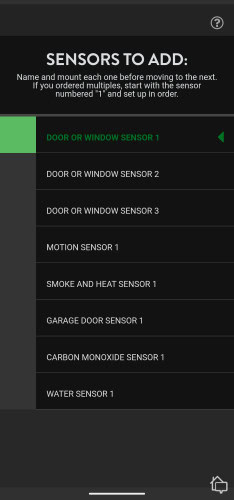
Our entire setup process hinged heavily on the Frontpoint app.
We began by installing the Frontpoint app and entering our activation code. The process took less than five minutes.
Next came the control panel configuration. We tested the Display Hub+ (touch screen), which includes the same Wi-Fi, cellular backup, and battery features as the standard Frontpoint Hub. While the panel handles most settings well, we preferred using the Frontpoint app and web portal.
The Display Hub+ comes with a handy desktop stand that makes placement flexible. We moved our device between the kitchen counter and bedroom nightstand before settling on a spot. A wall mounting kit is available separately if you prefer a permanent spot.
FYI: Frontpoint sends friendly reminder texts if you haven’t set up your system after a few days. Don’t wait too long. Your three-year warranty kicks in either when you activate or 30 days after purchase, whichever happens first.
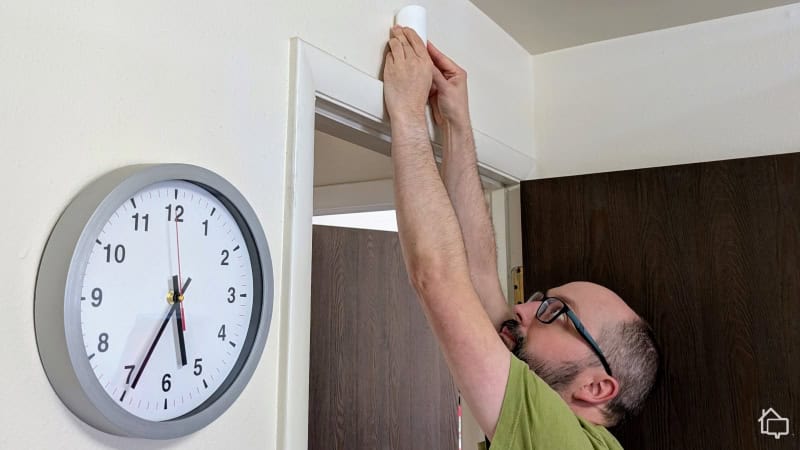
Installing the Frontpoint control panel and sensors took less than 20 minutes.
Frontpoint preprograms every security sensor before shipping your order, which makes it easy to set up and install most of the security system. The only things you need to do are choose where to place your sensors and verify they’re working before installing them.
We installed all sensors using the included adhesive strips, averaging less than a minute per sensor. A ladder was our only tool. We needed it for mounting the motion sensor, glass-break sensor, smoke detector, carbon monoxide detector, and door/window sensors in elevated positions.
Did You Know? We ran several break-in scenarios to test the system’s response. Each time, our phone buzzed with notifications within seconds. Frontpoint’s monitoring team called shortly after. It was reassuring to know they’re actually watching.
The motion, smoke, and carbon monoxide sensors include mounting screws and wall anchors for permanent installation. We suggest using them for long-term installations (three-plus years). Keep in mind that drilling anchor holes takes extra time and tools.
You can set up home automation to trigger lights and cameras based on sensor activity, though Frontpoint doesn’t let you adjust individual sensor sensitivity. What you can do is customize the chimes and voice announcements. We set ours to announce “front door open” versus “back door open” so we always know which entrance was being used.
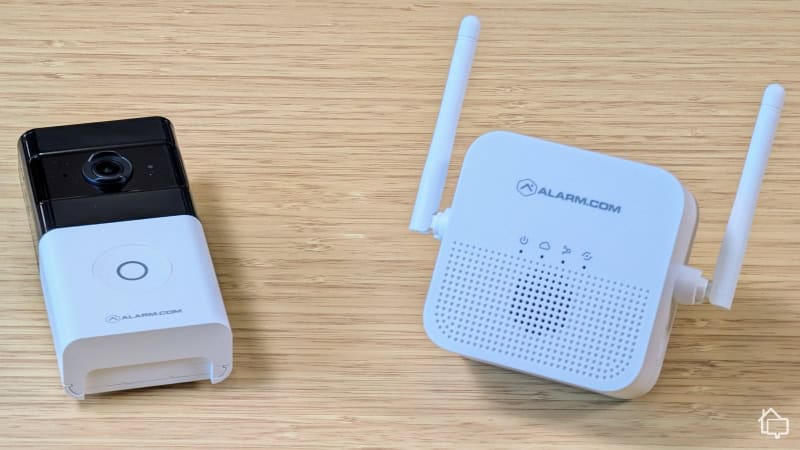
Setting up the Smart Chime was the hardest part of our Frontpoint installation.
The Smart Chime setup was the trickiest part of our entire installation. The Smart Chime is primarily a wireless chime for the wireless doorbell camera, but it also doubles as a Wi-Fi access point to extend the range of your Frontpoint cameras. Basically, you connect it to Wi-Fi, and then connect your cameras to it. That’s why Frontpoint recommends setting up the Smart Chime before the security cameras.
The included instructions were confusing. Despite connecting our phone to the Smart Chime’s network, the Frontpoint app couldn’t detect it. We checked Frontpoint’s online support resources and found their Smart Chime Master Guide, which didn’t match our physical manual.
The crucial step we missed was that you need to type “192.168.173.1” directly into your phone’s web browser to access the setup page. Once we figured that out, everything clicked into place and the app recognized the device immediately.
>> Related: The Best Home Security Systems With Doorbell Cameras
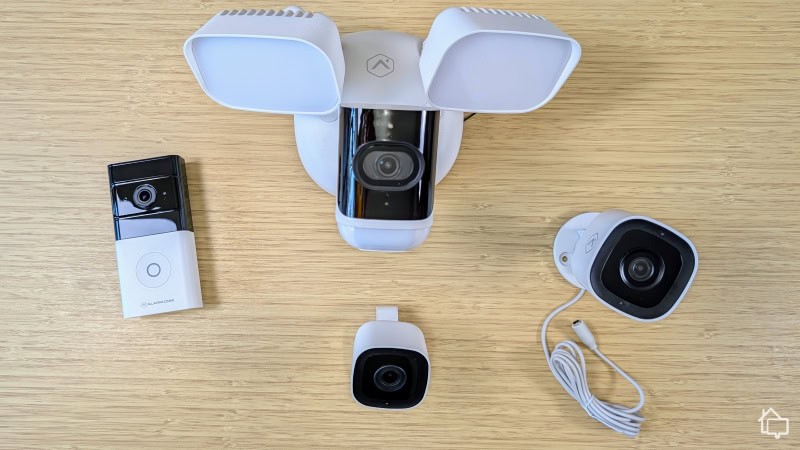
The four Frontpoint security cameras we tested: premium floodlight camera (top middle), outdoor camera (right), indoor camera (bottom middle) and wireless doorbell camera (left).
Setting up cameras was less challenging than the Smart Chime, although each camera required a factory reset. The wireless doorbell camera’s 45-second reset process was particularly lengthy.
We recommend skipping the app’s “bulk setup” option. It failed repeatedly for us. Instead, add each camera individually through the app. It might take a bit longer, but it actually works.
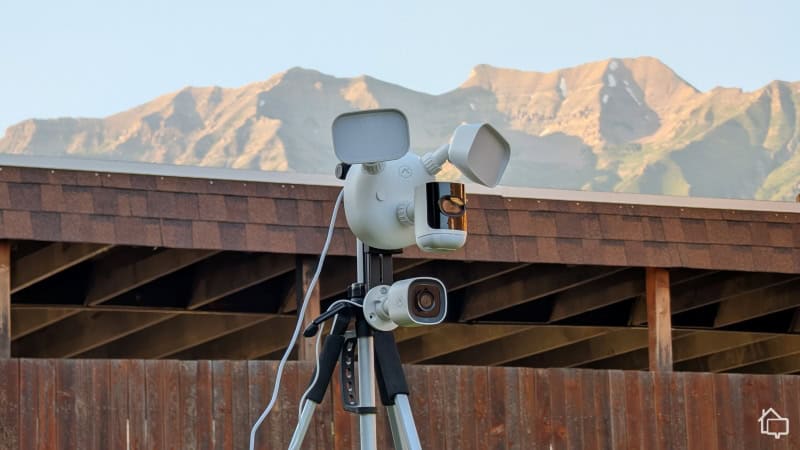
Although we didn’t install the cameras in permanent locations for our testing, the same instructions applied to our mounting blocks.
We recommend planning for 10 to 20 minutes per camera. The time may vary depending on your mounting and drilling requirements. Wall-mounted installations are straightforward. The wireless doorbell, outdoor camera, and premium floodlight camera need multiple screw holes, though.
The indoor camera has a wall mount, but we prefer the built-in stand, which is perfect for placing the camera on a high shelf. The doorbell camera’s bracket includes an angle wedge for downward adjustment on certain porches.
The biggest challenge we faced was dealing with power cords. Every camera except the wireless doorbell needs to reach an outlet. We ended up drilling through exterior walls for the outdoor cameras. If that sounds like too much work, running cables along walls with cord covers is another alternative.
Expert Insight: From its bulky body and hardwired installation to the two protruding floodlights, the premium floodlight camera from Frontpoint is similar to ADT’s Nest Cam with floodlight. Check out our experience with that other camera in our ADT security system hands-on review.
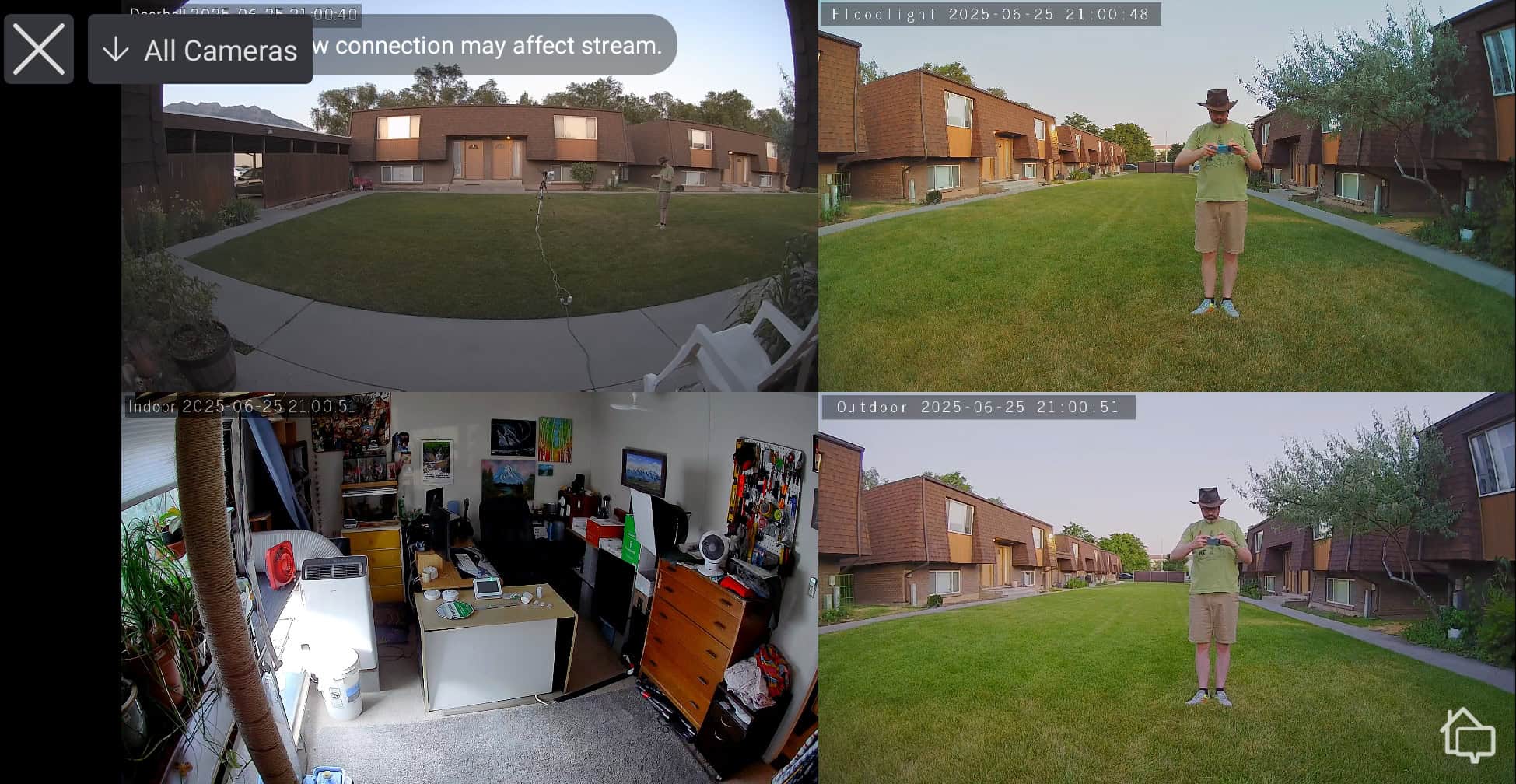
You can tie camera recordings to alarm modes so they record only when you arm the Frontpoint system or when an alert triggers.
Thankfully, using a Frontpoint camera is much easier than setting it up. Let’s run through a few features they share before highlighting their strengths and weaknesses. Here’s what every Frontpoint camera has in common:
Now that we covered the features you can expect from every Frontpoint camera, let’s dig into more specifics about each camera and your options for recording footage.
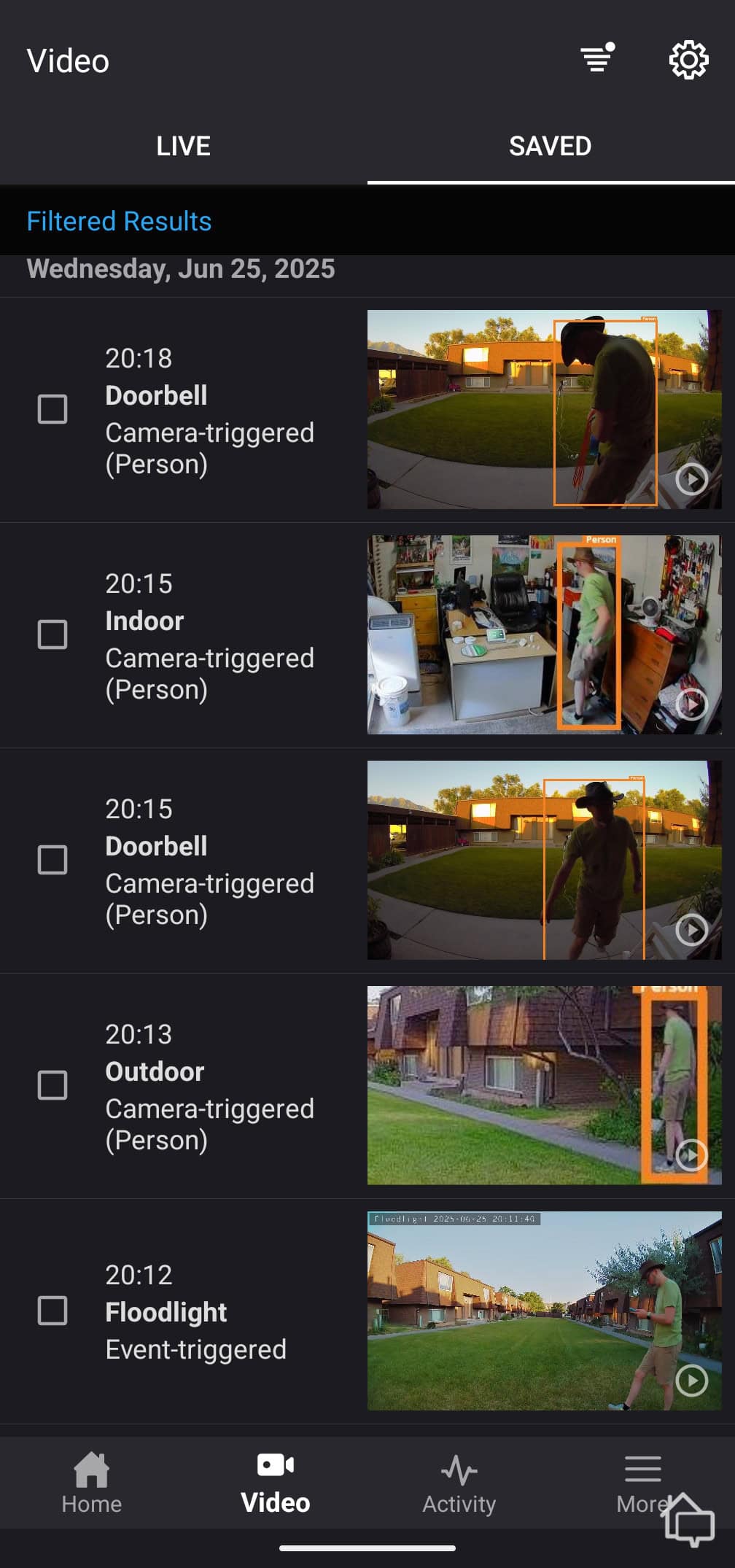
Frontpoint’s flexible video storage options are a nice perk.
For video storage, Frontpoint lets you store up to 3,000 clips per month with the Ultimate Monitoring plan. That sounds like a lot, and for our four-camera setup, it was more than enough. We averaged about 1,500 clips monthly even during our testing period. If you need more, though, you can buy additional cloud capacity as an add-on.
We also like that Frontpoint’s indoor, outdoor, and floodlight cameras all accept microSD cards for local storage. This means you get continuous recording locally plus motion-triggered clips in the cloud. It’s the best of both worlds and something you won’t find with most security system cameras.
Most cameras for home security systems don’t include onboard storage, let alone support for microSD cards. Eufy (used by Cove), Google Nest (used by ADT), SimpliSafe and Ring rely exclusively on cloud storage. Only some Vivint cameras match Frontpoint’s local storage capabilities.
>> Read More: Our Review of Vivint Security Cameras
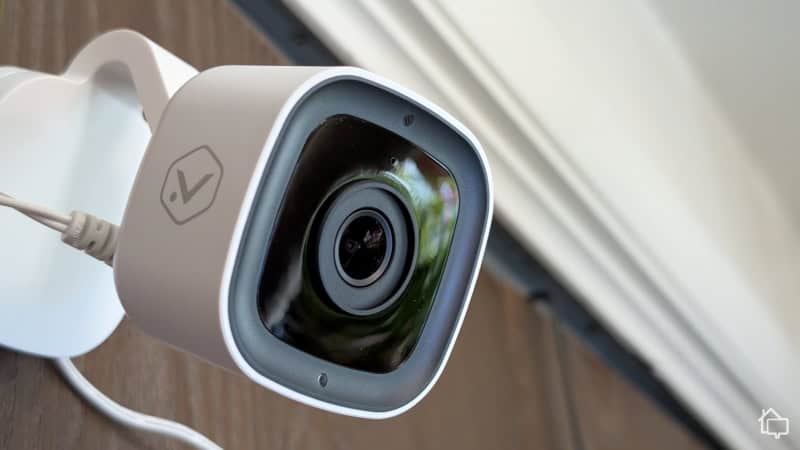
The indoor camera is very easy to use.
The indoor camera’s biggest strength is its easy setup and placement. The cord was even long enough to reach high shelves far from the power outlet. It’s not the most technologically advanced device around, but it’s a reliable indoor camera that does exactly what it’s supposed to do without any fuss.
>> Other Options: Best Home Security Cameras of 2026
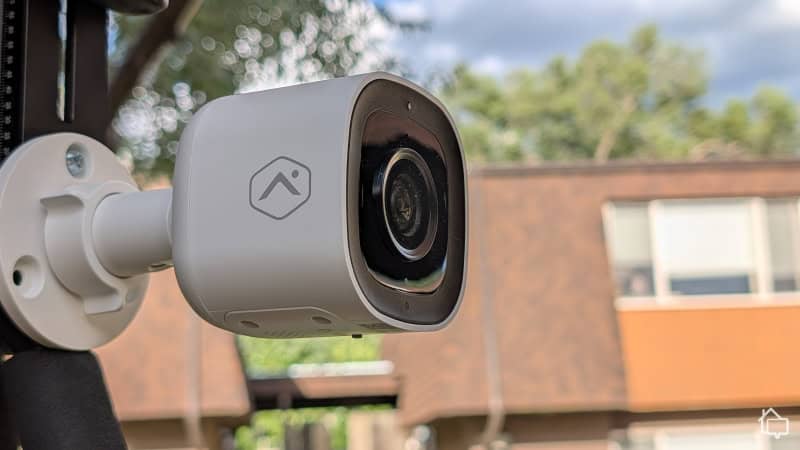
The outdoor camera showed a clear view of the courtyard outside our home.
We like the outdoor camera’s relatively compact design, metal case and weatherproofing. Its cord isn’t much longer than that of the indoor model, though, so you’ll need a nearby sheltered outlet outdoors if you don’t want to run the cable indoors.
The AI Deterrence feature shouts custom warnings at intruders. Just remember it costs extra and you only get 10 deterrence actions monthly, so use them wisely.
>> Other Options: The Best Outdoor Security Cameras of 2026
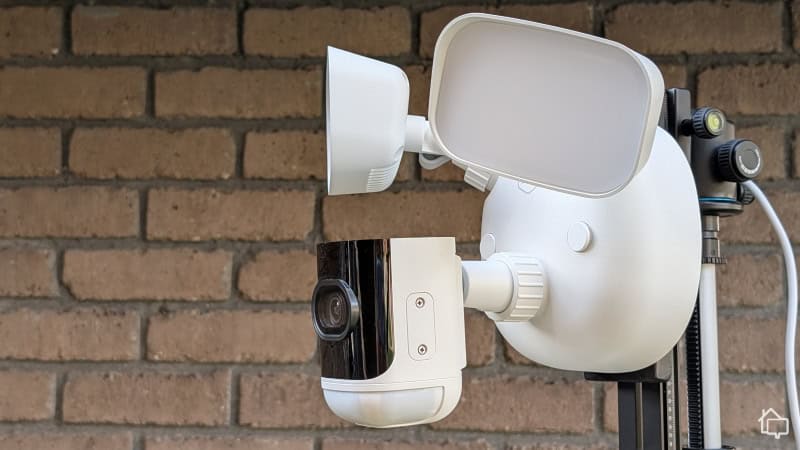
You can reposition the bright floodlights and camera to target specific areas in your yard.
Frontpoint’s premium floodlight camera is large and visually intimidating, especially if you create an automatic recording rule to illuminate unwelcome nighttime visitors. We love that you can control the lights separately from the camera. We programmed ours to turn on automatically when we open the back door at night. It makes those late-night trips to take out the trash much safer.
>> Compare: Ring Floodlight Cam Review in 2026
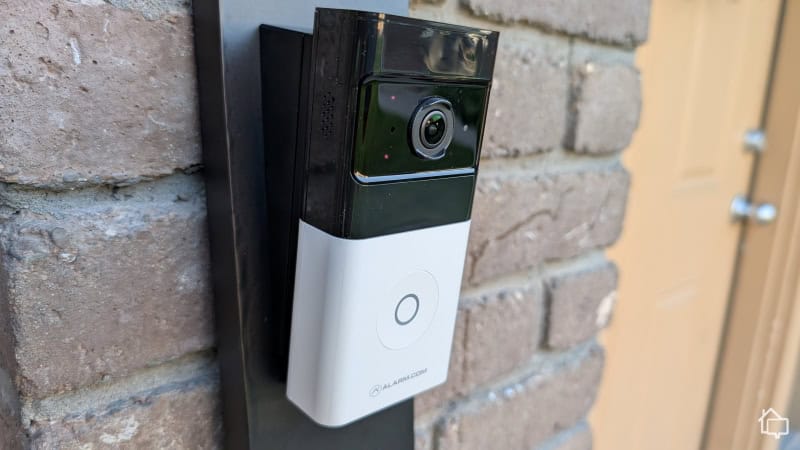
Because there’s no wiring to mess with, you can install it anywhere, like on a gate at the edge of your property.
We found the wireless doorbell camera needs recharging every three months. It requires the Smart Chime to work. It was a hassle to set up, but the Chime’s customizable tones and ability to boost Wi-Fi range are nice upgrades over an existing mechanical chime.
>> Other Options: The Best Video Doorbell Cameras of 2026
Frontpoint’s hardware generally worked as expected, but that’s only half the equation. We were also interested in finding out how well Frontpoint responds to alarms, especially because the system requires professional monitoring to work. Not to spoil anything, but Frontpoint made our list of this year’s best monitored home security systems.
One thing we liked about Frontpoint is its use of dual-path communication — the main hub essentially communicates via Wi-Fi and cellular signals, whichever is available. Think of it like having a backup generator for your internet. If your Wi-Fi fails, the system connects to the cellular network. Your system stays online no matter what. It’s thanks to this dual-path technology that Frontpoint made our list of the best cellular security systems.
Frontpoint has a 30-second entry delay by default. That means you have 30 seconds to disarm the system after triggering a sensor, such as when a door sensor is triggered after you enter the front door. That gives you time to cancel outgoing false alarms. You can extend this up to three minutes if you need more time. We found 30 seconds was plenty for us, even when fumbling with groceries. Keep in mind that during those 30 seconds, Frontpoint won’t be notified.
If you don’t disarm the system during the entry delay period, the triggered sensor sends an active alarm. That’s when Frontpoint’s monitoring center is notified, triggering an alarm response that goes like this:
In our testing, the whole process typically wrapped up within 30 seconds after the entry delay. That’s well within the industry’s 60-second average. We recommend responding to the text alert immediately to cut this time in half.
FYI: Text alerts beat phone calls by about 10 seconds in our tests. Plus, the text includes a quick link to cancel or confirm the alarm right from your browser. That’s similar to what we’ve seen from SMART Monitoring from ADT, one of the best security systems with fast response times.
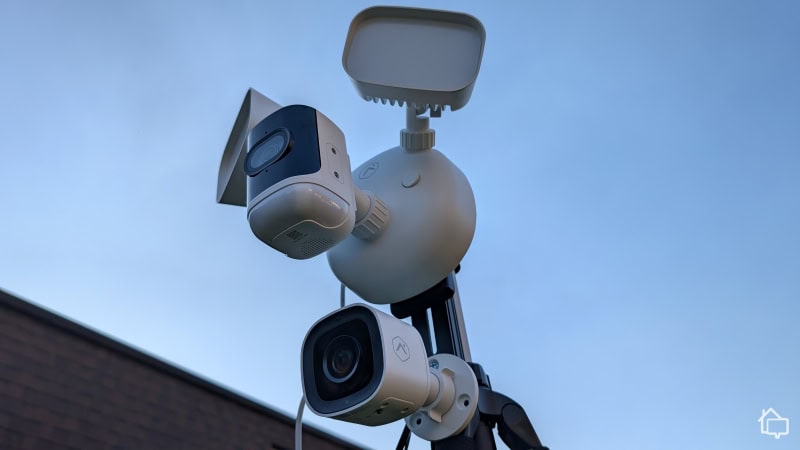
Frontpoint’s monitoring center uses security cameras to verify and score alarms in order to speed up police response.
We also discovered that Frontpoint uses video verification to potentially speed up alarm response. They follow the Alarm Validation Scoring Standard (AVS-01) from the Monitoring Association. That standard sets an alarm level score for each alarm event. The highest levels — 3 and 4 — mean there’s a confirmed threat to property (e.g. burglary in progress) and confirmed threat to life (e.g. home invasion), respectively.2
Following a standard like the AVS-01 makes the flow of information between monitoring centers and law enforcement smoother during real emergencies. Several well-respected names in home security are already using AVS-01, including ADT, SimpliSafe and RapidResponse (Frontpoint’s monitoring partner).
>> Compare: ADT vs. SimpliSafe
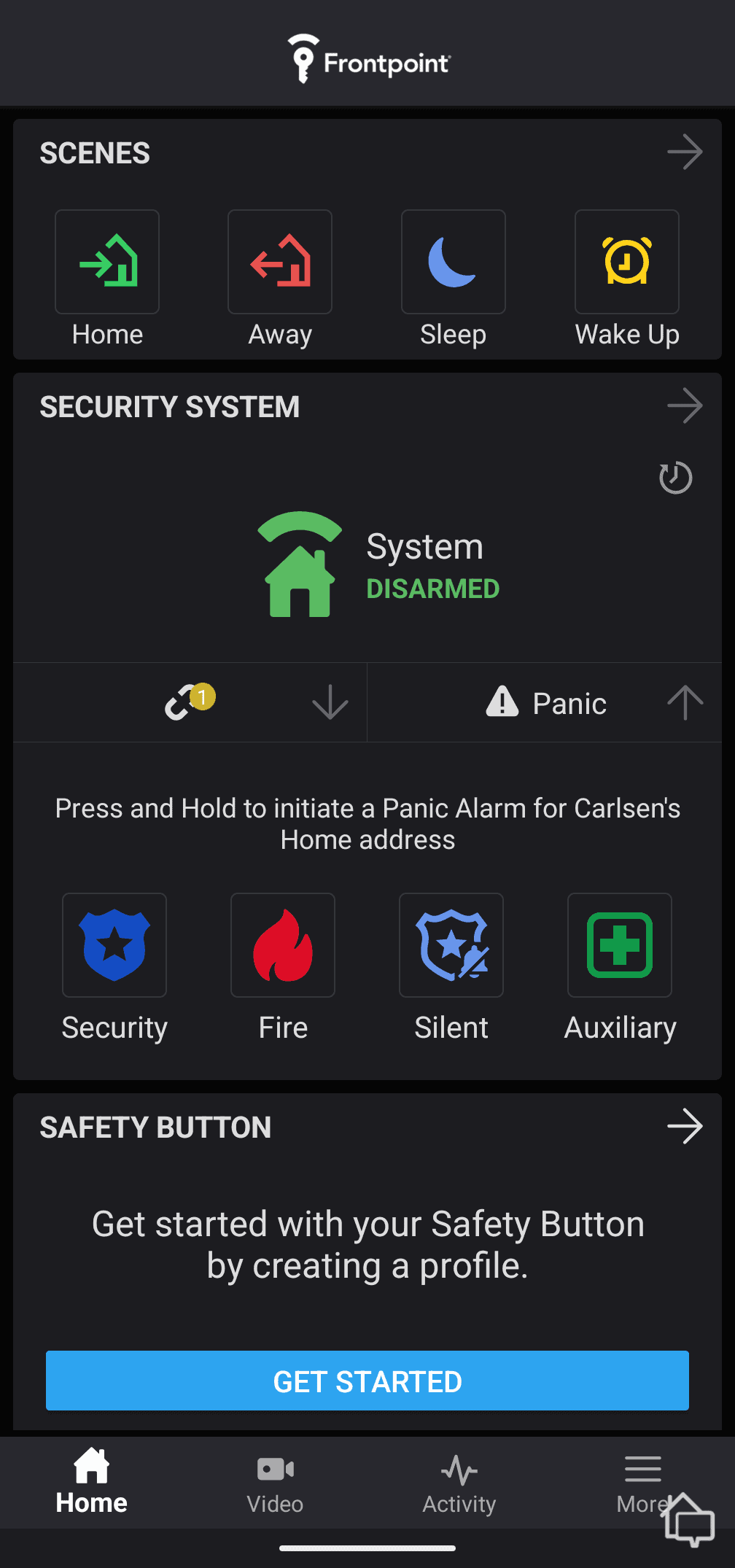
Aside from the few issues we had setting up our cameras, the Frontpoint app is easy to use with a layout that makes sense.
Like Frontpoint security systems, the app home screen is customizable. As you can see above, our arm/disarm option is front and center for easy access. We also preprogrammed phone numbers for the fire department and ambulance, just in case.
The Scenes section gives us easy access to home automation features. Pressing the home button disarms the security system, unlocks the smart lock on the front door and double-checks our garage door is closed. The sleep sequence switches off our smart lights, locks all doors and confirms the windows closed via entry sensors.
FYI: You can use the Frontpoint Alexa Skill to control your system with Echo smart speakers and displays. This gives you control over arming, smart devices and scenes. The system also works with Apple Home and Siri, but it isn’t compatible with Google Home.
Frontpoint also lets you add third-party smart-home devices to automations, including those using the Z-Wave smart home protocol, but only those listed in its Third-Party Compatible Products Guide. The smart home automations cover the basics, with time-, event- and location-based triggers in addition to the manual controls. The automation rules work well with Alexa and Siri.
The Frontpoint app can do more than automations. You can check your video feed, review events and adjust settings for every device connected to your system. We also set up a geofence. When we leave the house in a rush, we forget to arm the system. Now Frontpoint alerts us when we’re outside the geofence. Instead of turning back, we arm it in the app.
We tested all of Frontpoint’s contact methods. We emailed them, filled out an online form and used web chat. It took a little longer than we would have liked for an email response, but the web chat responses were fast and friendly.
Calling Frontpoint is the best way to get questions answered. We spoke to two different consultants on separate occasions when we had an issue with connecting our camera to the Wi-Fi. The support from both Frontpoint representatives was excellent and they managed to solve our problem quickly and efficiently.
The Frontpoint security system is a solid low- to mid-priced option for most homeowners. We think it’s worth considering for folks who aren’t interested in pricier and more sophisticated Vivint or ADT home security systems. This is especially true when you buy Frontpoint gear during one of the brand’s regular sales. The three-year contract for this DIY home security system can’t beat the month-to-month options from SimpliSafe or the flexible contract terms from newer competitors, though.
On the equipment front, Frontpoint’s compatibility with a relatively large number of smart-home devices gives it an edge over SimpliSafe’s weaker smart-home offerings and holds strong against most other competitors. Even though the setup process for Frontpoint security cameras didn’t go as smoothly as we hoped, the cameras are straightforward to learn for most people.
If you’re a renter, your best bet is to go with a month-to-month contract option, which may be harder to get with Frontpoint than with rival brands such as SimpliSafe and Cove. The three-year contract option, however, is probably better for homeowners who are comfortable committing long term.
Our team of security experts leverages years of experience to provide our readers with reviews that accurately represent how security systems perform in real-world settings. Essentially, we test security systems in our own homes. We follow each security provider’s ordering and setup process like a typical homeowner.
After installation, we spend a week or two learning each system’s features, quirks and drawbacks. In addition to using a system during our everyday schedule, we simulate alarms, test sensors and evaluate security cameras to see how these line up with our experiences on other security systems.
If your Wi-Fi drops out, Frontpoint connects to Verizon’s cellular network. The hub only uses cellular to communicate with the Frontpoint monitoring center for faster responses.
Frontpoint offers month-to-month and three-year contracts. The three-year contract applies only if you’re financing your equipment.
No, you’ll need to subscribe to a professional monitoring plan for your Frontpoint system to work.
Yes, it does. You can integrate all current Google Nest Thermostat models and any thermostats that use Z-Wave connectivity. The best part is you can add the third-party devices into your home-automation routines.
SimpliSafe offers more affordable equipment and monitoring plans, including a free self-monitoring option. If you’re looking for smart-home automation features, Frontpoint is the better choice.
Federal Trade Commission Consumer Advice. (2023). Solving Problems With a Business: Returns, Refunds, and Other Resolutions.
https://consumer.ftc.gov/articles/solving-problems-business-returns-refunds-and-other-resolutions
The Monitoring Association. (2024). ANSI/TMA-AVS-01 2024 Alarm Validation Scoring Standard.
https://tma.us/standards/tma-avs-01-alarm-validation-standard/#Alarm